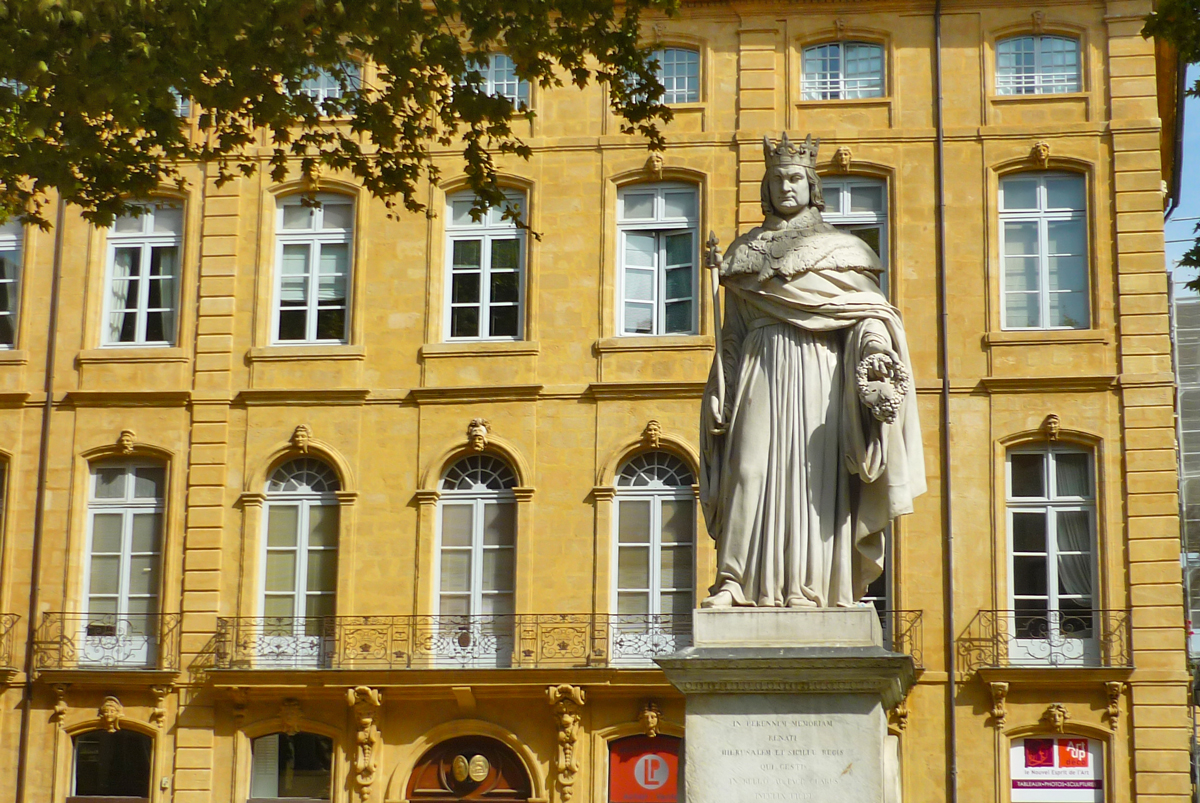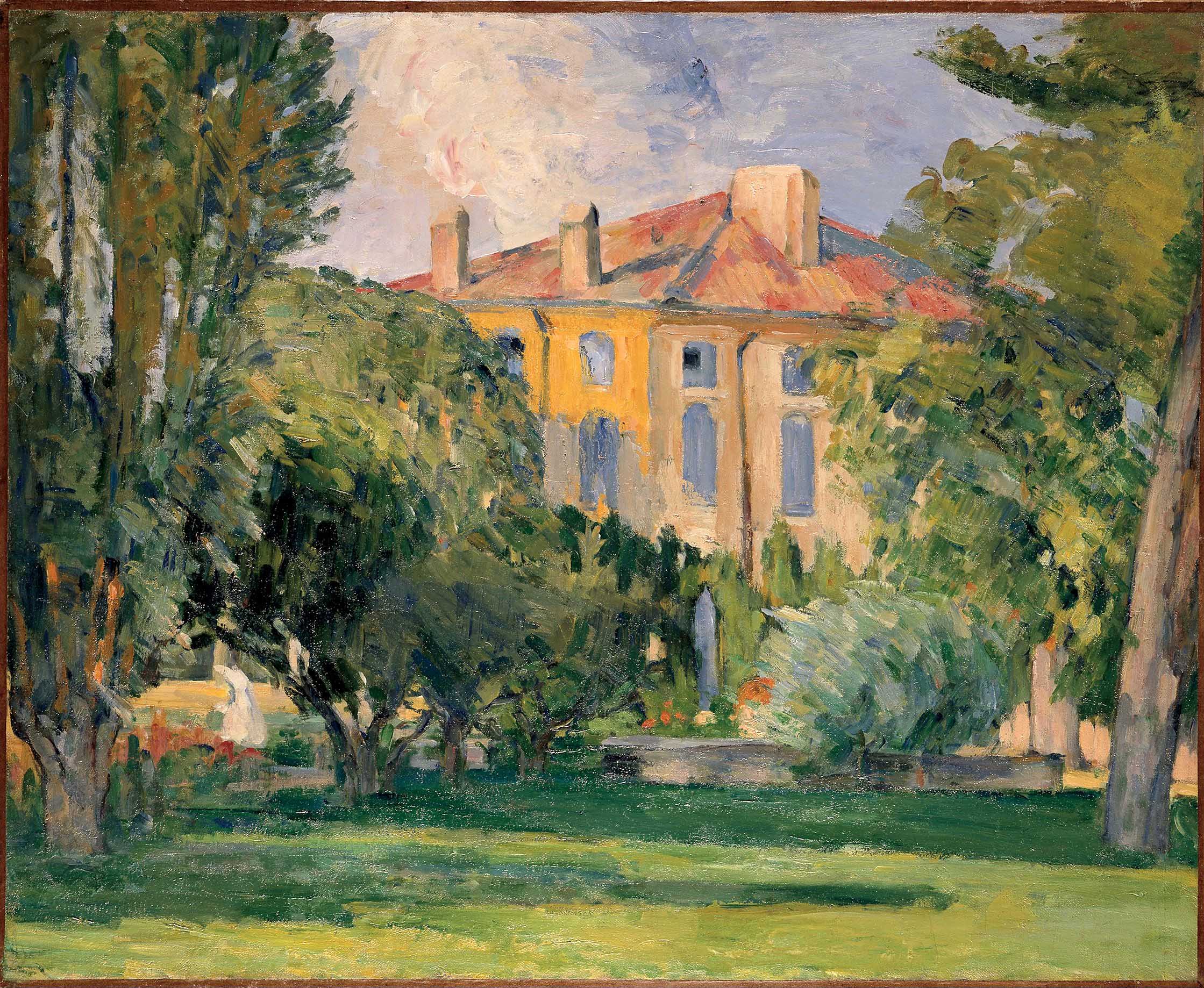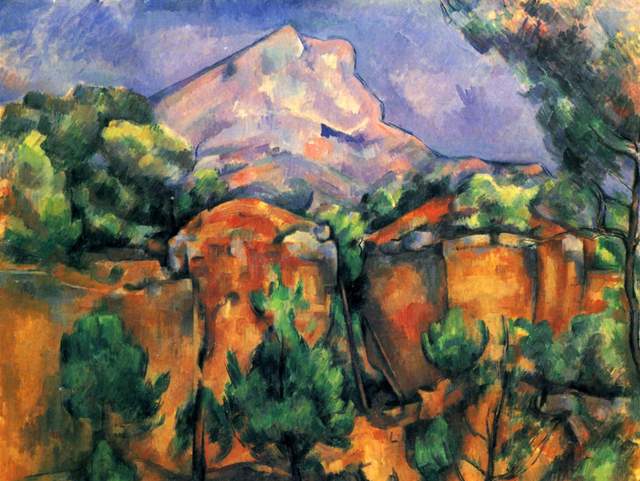This is a brief account of Aix-en-Provence history. Its past is reflected in the churches and rich 17th and 18th-century manor houses in the old town. It is these witnesses to Aix’s history that attract the many tourists who come to discover the water city of the Romans.
Aix-en-Provence History
From the Roman era to the 19th century, the capital of King René has lived through the great historical events of Provence.
Roman origins in Aix-en-Provence

The Aixois (the region around Aix) first belonged to the Salyans, a Gallic federation of several peoples of Lower Provence. The Salyans settled in the oppidum of Entremont.
In 122 BC, the Roman consul Caius Sextius Calvinus created the town of Aquae Sextiae at the foot of the Entremont oppidum. It was this Roman town that later became Aix. Situated on a strategic axis between Italy and Spain (on the Via Aurelia), Aix allowed the Roman Republic to secure an entire region that was then in the hands of the Salyans.
However, enemy incursions threatened the security of Narbonne Gaul, and, in 102 BC, the consul Caius Marius destroyed an army of Cimbres and Teutons, by a mountain which was renamed “Sainte-Victoire“. This battle, known as the Battle of Aix, protected Italy from invasion by these Germanic tribes. At the same time, Aix developed and took on the characteristics of a Roman city. It had a forum but also a theatre, baths and aqueducts.
The 3rd century AD was marked by the beginning of the demographic decline of Aquae Sextiae. At the same time, Aix was the capital of the Narbonensis Secunda region. The city dominated major ancient cities such as Fréjus (Forum Julii), Antibes (Antipolis), Riez (Reis Appolinaris), Apt (Apta Julia), Sisteron (Segusterone) and Gap (Vapincum) on a political level.
Because of several wars which took place around Aquae Sextiae, most of the Roman monuments have been destroyed. But in 2004, a Roman theatre was discovered in the suburb of Notre-Dame-de-la-Seds. It has since become Aix’s most famous ancient monument.
The Barbarian Invasions and the decline of Aix
As a result of several invasions and occupations during the Barbarian Invasions (successively the Ostrogoths, Visigoths, Franks, Lombards and Saracens), Aix lost its status to Arles. The city’s enemies tried to deprive the city of water by destroying the aqueducts. However, the existence of several water tables enabled the inhabitants to survive. Nevertheless, Aix was politically and economically ruined.
Aix-en-Provence history during the Middle Ages
An archbishopric was created in Aix, which ensured it a pre-eminent position throughout the Middle Ages, confirmed by the creation of a university (1409), then shortly after the attachment to France, of the Parliament of Provence (1501).
In 1189, the Counts of Provence decided to make Aix their new place of residence, to the detriment of Arles and Avignon, which they had been living in until then. Aix then became the capital of Provence.

However, Aix did not regain its splendour until the 11th century when the Counts of Provence (houses of Anjou and Aragon) held a refined and literate court there.
In 1357, the city walls were revised and improved.
On the death of Jeanne I of Naples (la Reine Jeanne), Aix was at the head of the Union d’Aix, a league of communities and towns in Provence that opposed the Angevin dynasty. The confederation eventually rallied in the face of promises from Marie de Blois. Louis II of Anjou entered the city on 21 October 1387.
Aix-en-Provence history and le Bon Roi René

Aix experienced another prosperous period in the 15th century under the good King René, Duke of Anjou, Count of Provence and titular King of Sicily.
King René, an enlightened spirit, transformed the city into a famous cultural and university centre (1409).
He organised popular festivals such as the Tarasque procession in Tarascon or the Fête-Dieu in Aix. The latter lasted several days and brought together hundreds of troubadours.
He was also responsible for the importation of the Muscat grape.
He married Isabelle de Lorraine, then Jeanne de Laval and died in Aix in 1480, aged 72.
Aix remained the capital of Provence until the French Revolution, thanks to this cultural influence.
French Aix and the Parliament of Provence

In 1486, the Kingdom of France annexed Provence. In 1501, King Louis XII established the “Parlement de Provence” (Parliament of Provence) in Aix. Most often, the States met there to vote on taxes.
This Parliament was so unpopular that a saying appeared:
“Parliament, Mistral and Durance are the three scourges of Provence”
In 1545, during the Wars of Religion, it was Oppède, the president of the parliament of Aix, supported by the cardinal of Tournon, who organised the massacre of the Waldensians in Luberon (Valais du Luberon).
During the struggle against Protestantism, the rebellious Waldensian community was decimated in the name of Catholicism. In five days alone during the repression, 3,000 people were murdered. Women were raped and men were sent into slavery in the galleys. The rest died from starvation following the destruction of their harvests by fire. Villages such as Lacoste and Ménerbes were completely ransacked.
After this episode, many people in the towns of Lourmarin, Saint-Martin-de-la-Brasque and La Motte-d’Aigues were part of the Huguenots who emigrated to South Africa. It is estimated that 200,000 French martyrs emigrated to South Africa, 50,000 of whom were Waldensians from the Luberon.
Aix’s love affair with Louis XIV
On his return from an expedition against the Huguenots in 1622, Louis XIII stopped in Aix, which welcomed him enthusiastically.
His son Louis XIV stayed several times in Aix.

He played at the Jeu de Paume, transformed in the 18th century into an Italian-style theatre of the same name.
It was in Aix that the Sun King signed the peace treaty with the Prince of Condé.
In 1660, when he was sleeping in the private mansion of Châteaurenard, he was dazzled by a trompe-l’oeil painting by Jean Daret (a Flemish painter). He had him appointed painter to the King at the Court of Versailles.
In fact, Aix felt a boundless admiration for the sovereign. In addition to the luxury of the festivities organised for his arrival, the population was concerned about his health, which deteriorated in 1685. But the announcement of his recovery provoked acclamations in the city, which organised a whole month of festivities in honour of the monarch.
A new district for Aix
The appointment of Michel Mazarin, brother of Cardinal Mazarin, as Archbishop of Aix resulted in a major expansion of the city to the south. With the authorisation of the King of France, he had the southern rampart demolished. He created a new district, representing almost a third of the city, enclosed in a new rampart further south.

This district, later called the Mazarin district, was designed with the advice of the architect Jean Lombard. The bourgeois, whose houses were located right up against the old rampart, asked that the area in front of their buildings be left undeveloped and become a promenade for onlookers and carriages. The authorities granted their request and the courtyard thus created became the gateway to the new town. It was not until 1876, however, that it was given the name “Cours Mirabeau“.

The new Mazarin district was expensive to build: over 55,000 pounds. This sum was shared by the municipality of Aix, under the constraint of the Parliament, property dealers, site buyers, the communities of Provence and the Duke of Vendôme, Louis de Mercœur. The builder archbishop, a highly controversial figure, by the way, left his name on several streets in this new district: rue Cardinale, rue Saint-Michel, today rue Goyrand, rue Mazarine and rue Saint-Sauveur (today rue du Quatre-Septembre).
![Aix-en-Provence old town - Fontaine des Quatre-Dauphins © Bjs - licence [CC BY-SA 4.0] from Wikimedia Commons](https://frenchmoments.eu/wp-content/uploads/2013/05/Fontaine-des-Quatre-Dauphins-©-Bjs-licence-CC-BY-SA-4.0-from-Wikimedia-Commons-scaled.jpg)
Aix-en-Provence history in the Grand Siècle
In the 17th and 18th centuries, the nobility of Aix decided to adorn the streets of the old town and the Mazarin district with opulent private mansions.
![Aix-en-Provence old town - Hôtel de Caumont © Bjs - licence [CC BY-SA 4.0] from Wikimedia Commons](https://frenchmoments.eu/wp-content/uploads/2013/05/Hotel-de-Caumont-©-Bjs-licence-CC-BY-SA-4.0-from-Wikimedia-Commons-scaled.jpg)
![Pavillon de Vendôme Aix-en-Provence © Georges Seguin - licence [CC BY-SA 4.0] from Wikimedia Commons](https://frenchmoments.eu/wp-content/uploads/2013/05/Pavillon-de-Vendôme-Aix-en-Provence-©-Georges-Seguin-licence-CC-BY-SA-4.0-from-Wikimedia-Commons-scaled.jpg)
Aix-en-Provence has more than 150 private mansions dating from the 16th to 18th centuries. This makes Aix the second-largest city in France (after Paris) in terms of the number of private mansions and the first in terms of the number per inhabitant.
![Hotel Boyer d'Eguilles © Johan Allard - licence [CC BY-SA 4.0] from Wikimedia Commons](https://frenchmoments.eu/wp-content/uploads/2013/05/Hotel-Boyer-dEguilles-©-Johan-Allard-licence-CC-BY-SA-4.0-from-Wikimedia-Commons-scaled.jpg)
Aix-en-Provence history during the Revolution
Aix-en-Provence is the historical rival of Paris. After the French Revolution in 1789, a number of different political forces struggled to become the next political regime, following the Old Regime’s fall. Two main characters embodied this struggle: Joseph Emmanuel Sieyes from Paris and Honoré-Gabriel Riquetti de Mirabeau from Aix-en-Provence.
During the French Revolution, there was a huge debate about the naming of the Third Estate MP. After a long argument, the debate came down to the opposing views of Sieyes and Mirabeau. Mirabeau had a complex role during the Revolution period. He had a kind of double role because he was the ‘man of the Assembly’ but he also retained close links to King Louis XVI. For instance, in 1790, by a secret contract, he became the King’s judicial councillor. Mirabeau wanted to keep the role of the King alive to ensure that political power was shared between the King and the Constitutional Assembly.
Sieyes wanted the King’s position to be “representative of the French nation” and national sovereign, whereas Mirabeau wanted it to be “representative of the French people” and to have the same political system as England.
In the end, the National Assembly decided to follow Sieyes and this is still a source of resentment for Aix-en-Provence people towards Parisians. In 1876, Aix-en-Provence’s main street was renamed Cours Mirabeau.

Aix-en-Provence history in the 19th century
Aix is known for having acquired the nickname “Sleeping Beauty” (la belle endormie) in the 19th century. This alludes to the lethargy, even immobility, of its urban administrators. This image was illustrated by Taine’s comment in 1866 that Aix was “fallen or left behind by the civilisation that moves on”.
However, from the 1850s onwards, Aix had a dynamic urban policy, which was embodied in the construction of new roads or the planned creation of new districts.
The main businesses in the town were chocolate, hat, soap, oil and nougat shops. This was a relatively undeveloped craft industry, which had to wait until the 1840s to develop.
In 1860, Aix acquired a monumental fountain which took pride in the Place de la Rotonde. The city’s gateway is the junction of the roads to Avignon and Marseille.

The railway was a long time coming to Aix
The railway came to the city late.
At the beginning of the 1840s, the PLM company created the line from Paris-Lyon to Marseille-Saint-Charles and the route passed far from the city.
Similarly, on 19 June 1857, an imperial decree decided to create a line from Gap to Avignon, without passing through Aix either.
In fact, the town suffered economically from these political decisions which isolated it in Basse-Provence. Local industries also suffered from this situation, as many depended on the trade of cattle and sheep with the Alps, among others.
Then, in 1870 a section was created linking Aix to Meyrargues and three stations for passengers and goods, at La Calade, Venelles and Meyrargues.
Finally, in 1877 a line was opened linking Aix to Marseille, via Gardanne. These new sections allowed Aix to keep a good part of its trade with the Durance regions, but this was a handicap in its trade, which gradually declined, and Marseille benefited from this.
Aix-en-Provence history in the 20th and 21st centuries
Just a few interesting dates:
The city of Aix, which had borne this name for more than a thousand years, after that of Aquae Sextiae, took the official name of Aix-en-Provence in 1932.
The 1970s, under the municipality of Félix Ciccolini, marked development in several respects that modified the economic face of Aix-en-Provence. Numerous companies and industries that generated employment opened in the Bouches-du-Rhône:
- the petrochemical complex on the Etang de Berre,
- the Cadarache nuclear research centre, in particular.
Aix benefited from these job creations and saw its population increase.
At the same time, the tourist boom saw more and more visitors passing through the city. This attractivity de facto led to the development of activities linked to this sector and, as a spin-off, allowed Aix’s culture to prosper. The lyric art festival is an illustration of this.
Today, Aix is a city that combines a historic past with a technological future, notably with the ITER project in Cadarache, the TGV station, and the Arbois and Rousset technology parks…
Aix is home to many universities and Grandes Ecoles (literature, law, economics, political science, arts and crafts, fine arts, etc.)
![Aix-en-Provence old town - Place des Cardeurs © Odejea - licence [CC BY-SA 4.0] from Wikimedia Commons](https://frenchmoments.eu/wp-content/uploads/2013/05/Place-des-Cardeurs-©-Odejea-licence-CC-BY-SA-4.0-from-Wikimedia-Commons-scaled.jpg)
Aix-en-Provence History and the local artists
Emile Zola (1840-1902)

Zola was born in Paris on the 2nd of April 1840. He moved to Aix-en-Provence with his parents when he was three. He went to the Bourbon school where he befriended the future painter Paul Cézanne. During the five years he spent in Aix, Zola went off on many adventures with Cézanne which he recorded. His notes focused on aspects of the city which would later appear in his writing. He had to leave Aix in 1858 but he returned every summer holiday and wrote frequent letters to Cézanne.

One of the most popular writers in France
Emile Zola is one of the most popular writers in France. Germinal, one of his famous novels, describes the difficult humanitarian conditions in the mines in the North of France during the nineteenth century. It is read in every school in France as a literary classic. He wrote a series of 20 novels called the “Rougon-Macquart”. It tells the story of two families under the Second Empire, from a naturalist angle. In the “Rougon-Macquart”, 5 novels take place in Aix-en-Provence (reinvented as “Plassans”). Zola tended to adopt Cézanne’s painting technique to create his book’s characters, portraying real subjects in real places.

Relationship with Cézanne and J’accuse
But little by little, Zola became less appreciative of Cézanne’s painting and in 1886, he wrote a novel called L’Oeuvre in which he drew his inspiration from Cézanne. He created the character of Claude Lantier who is a failed artist. Cézanne was hurt by this portrayal, which was barely veiled. Zola and Cézanne never met again.
Zola’s commitment to politics began in 1898 when he vehemently took part in the famous “Dreyfus Affair”. He wrote his famous open letter “J’accuse” in a French newspaper which sent shockwaves through political circles.

He died on 29 September 1902, suffocating in his Parisian apartment as a result of a blocked chimney.
Paul Cézanne (1839-1906)

Born in Aix-en-Provence, Cézanne met Émile Zola in the school courtyard. These inseparable friends roamed the countryside around Aix during the holidays. They read poetry in the wild and experienced the intense sensations of being at one with nature.

When Zola moved away to Paris, they began corresponding. Cézanne continued his studies against his will, but he also continued painting. He went to Paris but he failed the entrance to the famous “École des Beaux Arts” and returned to Aix. His father was always against his son’s desire to be a painter but he finally gave him an allowance, so that he could be free to be a full-time artist.

When Cézanne moved to Aix-en-Provence in 1890, the aesthetic debate among the city’s artists intensified. Two camps emerged that were traditionally antagonistic:
- the people attached to tradition
- those who wanted modernity.
Most of his paintings are of the Aixois (Aix’ countryside), especially the Sainte-Victoire Mountain.

In October 1906, while he was painting in the wild, he was caught out in a storm and died from pneumonia eight days later at the age of 67.
Where to stay in Aix-en-Provence?
You can choose from a great range of accommodation in Aix-en-Provence, from hotels to B&B and campings! My recommendation is to book your accommodation near the city centre. Although it’s a more pricey option, you’ll save time on transportation and can access most of the 10 things to see within walking distance.
Also, when possible, don’t wait until the last minute to book as finding hotel rooms can be a problem, especially on weekdays.
To book your accommodation in Aix, click on this affiliate link which will redirect you to our partner booking.com… or use the interactive map below:
Things to do in Aix-en-Provence
Looking for activities and things to do in Aix-en-Provence and its surroundings? Check out the offers from our partner Get Your Guide:
Pin Aix-en-Provence History for later!



Aix-en-Provence History: Find out more!
All our pages about Aix-en-Provence on the blog:
- Practical info for planning your visit to Aix-en-Provence
- Aix-en-Provence Old Town: A Discovery Guide
- Cours Mirabeau, Aix-en-Provence
- Aix-en-Provence Cathedral: A Discovery Guide
- Place de l’Hôtel de Ville of Aix-en-Provence
- Place d’Albertas: an elegant square in Aix-en-Provence
- The Calissons of Aix: a Specialty Candy from Provence
- Montagne Sainte-Victoire: the iconic mountain of Aix
- Around Aix-en-Provence: 10 Beautiful Places to Visit
More info about Aix-en-Provence:
- Discover the historic and cultural region of Provence on the blog
- Visit the Tourist office board of Aix-en-Provence
- Read more about Aix-en-Provence old town on Wikipedia
- Book your accommodation in Aix-en-Provence




